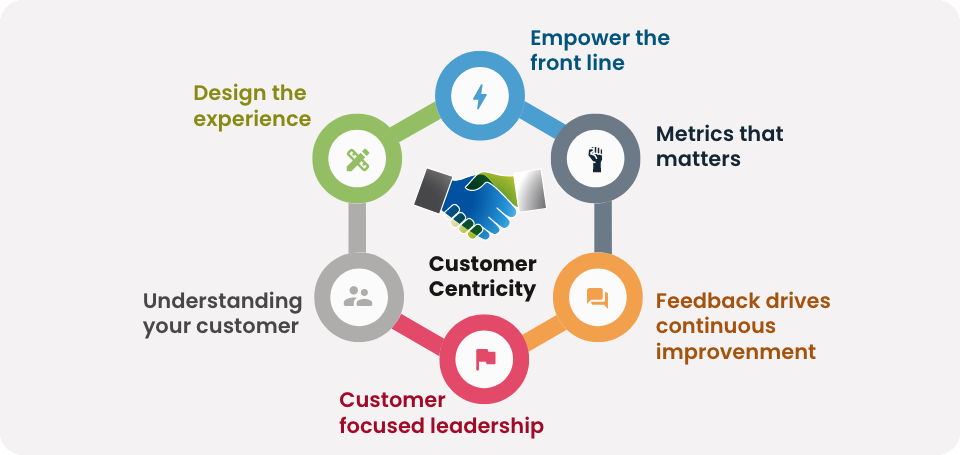How to Build a Successful Customer-Centric Culture

The term ‘customer-centric culture’ might feel self-explanatory. While it does entail that you put your customers first, it only scratches the surface of “customer-centric”. To truly define its aspects, many researchers have spent a good amount of time thinking about it.
The author of the Handbook of Human Resource Management Practice, Michael Armstrong, defines company culture as a framework of values, norms, and beliefs that may not have been articulated but shape the way in which people in an organization behave.
When you see customer experience at the core of what your company does, you pave the path for a customer-centric culture. Customer satisfaction, then, brings meaning to your organization, dictating your internal and external communication while acting as a driving force for action.
Customer-centric organizations make it a point to understand their customers and act on that understanding. They create a culture that empowers their employees to make the right decisions that benefit both the customer and the company.
As a concept, it has been around for quite some time with companies trying to integrate it in how they function for nearly 20 years. Yet, as per a CMO council report on mastering adaptive customer engagements, only 14% of marketers feel that their company really puts the focus on a customer-centric approach.
So what does it mean to have a customer-centric approach and how does it help companies to sustain long-term growth? This blog attempts to answer these questions.
How Do You Identify a Customer-Centric Company Culture?
When one in three customers will leave a brand after just one bad experience, it is important to identify if your organization fits the bill.
Some of the biggest names in the industry have spent years creating a culture around the customers and their needs–making sure that their commitment stays genuine through the customer lifecycle.
The following questions can be a thought-starter and act as a barometer for you:
- How does the company feel around me?
- What are the focus areas for the leadership team?
- How is the industry perceiving my company?
Why is Customer Centricity So Important for Your Business?

Take the brands you love interacting with. These brands have created a niche for themselves for the experience they provide. They make it easy for customers to do business with them. They communicate with you through a medium of your choice.
Customers today have an easy choice to walk away from brands they have a bad experience with. So for businesses, it is even more crucial to deliver on their promise.
A customer-centric strategy is not just to do with having customer service representatives who are in direct line of contact with your customers.
A study by the Harvard Business Review highlights that the acquisition of a new customer is about five to 25 times more expensive than retaining an existing one.
Considering its game-changing importance, why do companies struggle to adopt a customer-centric mindset? This can be attributed to a wide range of factors which we have highlighted in our next section.
The 3 Barriers to Embracing a Customer-Centric Mindset
Being customer-centric is easier said than done. A lot of organizations face some roadblocks when they start to make this vision a reality. Here are some of the challenges:
#1. The Failure to Integrate it in Value System
A customer-centric culture is not something that can be forced or easily changed. What it requires is the proactive contribution from everyone to embrace it.
Unfortunately, many culture-change initiatives tend to lose their momentum for a number of reasons.
For instance, the initial excitement of becoming a customer-centric organization does not sustain itself as many individuals revert to their old habits. Additionally, if such initiatives are not followed with retention strategies, the initiative would lose traction as well.
#2. Failure to Embrace the New Way
If employees see their managers behaving in ways that go against the company’s customer-centric vision, they might get the impression to do the same.
Organizations that adopt customer-centricity make use of a top-down approach in which managers embrace the change. Only then will they be well poised to lead their team in the direction.
#3. Reverting to Old Ways
Processes and operations don’t come to a halt when companies are going through a culture change. No matter what benefits a customer-centric strategy might bring to the table, integrating it to work on a day-to-day basis can be challenging.
For this perception to change, the leadership teams need to have conviction and commitment to bring over a company-wide transformation.
The 6 Key Points to Building a Customer-Centric Culture

Employing the below-mentioned customer-centric best practices will help you to achieve your vision.
#1. Integrate Customer Empathy
Customer empathy is the ability to identify your customer’s pain points and emotional needs, understand the thought process behind it and act accordingly.
Many organizations that ace it here encourage employees to spend some time observing their customers. They hire people who know how to express empathy through the written word.
Similar to the idea of a golden rule, empathy is a concept that everyone understands. While it cannot be quantified by a formula, employees can definitely be trained to infuse it in their processes.
#2. Brainstorm
Your vision statements are your go-to source of inspiration when it comes to adopting a customer-centric mindset.
Now that you have your customer-centric vision in place, you need to devise practices where your people get to live these ideals. Brainstorming with your teams can help you devise a roadmap.
#3. Recognise the Members Who Are Living Your Vision
Your team members might feel daunted to adopt new practices aligned with the new vision. But when you recognise those who go the extra mile in embracing a customer-centric mindset, you make way for a collective sense of pride.
Such people can also inspire others to follow in their direction.
#4. Connecting Culture with Customer Outcome
An effective way to keep managers and their teams motivated is to highlight how a customer-centric culture impacts results. Businesses should ensure that they establish a clear link between culture and customer impact.
When you have an enhanced employee engagement model, your client experience scores will see an uptick.
#5. Start with the Leadership
A Harvard study highlights that while CEOs spend about 72% of their time in meetings, only 3% of their average time in a week goes to interacting with customers.
Unless leaders start to practice what they preach, the dream of company-wide customer-centricity will never be realized.
#6. Measure It
You won’t know how successful you are if you don’t measure your initiatives. Create a continuous cycle of reviewing and be willing to accept errors. It is also crucial to go beyond churn reduction and lifetime customer value.
Ask what your customers are thinking. You can also make use of customer surveys and social media platforms.
Parting Thoughts
People do businesses with a company, and not departments in that company.
Having a customer-centric strategy can lend your company a unified voice. The payoff for your efforts will be the growing number of loyal customers who want to interact more and are more willing to let go of minor errors.
This is because they trust your brand and know that your business will take care of their needs in the long run.
Company leadership is starting to recognise the intrinsic role of a customer-centric approach and how it is closely tied with strategy.
By creating a customer-centric mindset, your business will have the right information at the right time so you stay ahead of your competition.




